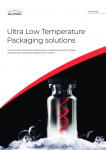bio 2022
Pandemic highlights need for supply chain visibility, partnerships

Government agencies in the US and around the globe learned some hard lessons about the pharmaceutical supply chain after the COVID-19 pandemic landed, causing problems and highlighting weaknesses in key areas. During the session “US Government Investments in Pharmaceutical Manufacturing and Supply Chain for Today’s and Future Pandemics” at the 2022 BIO International Conference, representatives from US health agencies the government has learned since the beginning of the pandemic, steps taken since COVID-19’s arrival, and plans the US has put in place to avoid problems in the future.
Kristin DeBord, acting director of the office of strategy, policy, planning, and requirements with the Office of the Assistant Secretary for Preparedness and Response (ASPR), a department within Health and Human Services (HHS), said an efficient, effective, and visible pharmaceutical supply chain—from raw materials to finished drugs and devices—are important through the recovery phase of a pandemic like COVID-19, but also day to day.
“I spend a lot of time thinking about any disruptions in our supply chain,” she said. “These can come from a number of different factors—regional lockdowns, trade issues, labor shortages, and more impact supply chain. They can delay or stop delivery altogether, and people are not getting what they need when they need it.”
DeBord pointed out the public health industrial base has evolved significantly, especially comparing pre-COVID days to now, two and a half years into the global pandemic. Pre-COVID, there was limited public health industrial base to address pandemic needs. Peak pandemic (from 2020 to 2021), events made industry and government leaders painfully aware of inadequacies in the supply of critical medical supplies, and leaders in the government and private sector leaped into action.
At this stage, demand and supply are showing signs of stabilizing, DeBord said; however, there must be continued investments in manufacturing to keep an even keel. The next step, she commented, is collaboration between governments around the globe and life-science leaders to build a greater level of resilience in the supply chain to respond to and weather future pandemics and other health events.
DeBord detailed some of the ways the pandemic shined a light on problem areas, including lack of stockpiling and lack of diversity in sourcing.
“The position before the pandemic was ‘just in time’ for our healthcare systems,” she said. “We didn’t have months and months of supplies—we were ordering it, and getting it, and using it—and that turned out to be a big vulnerability for us.”
DeBord added that a dependence on foreign sourcing of materials and supplies in the health supply chain presents issues.

“There's been a huge dependence on foreign sourcing for many of these supplies—there needs to be a kind of diversity of our supply chain,” she pointed out. “We agree that it cannot be all domestic—we have had some focus in that area—but it does need to be globally or better distributed. We were finding that some of the things we were buying that we needed are coming from a single location, and that causes a problem.”
The current US administration places a high priority on solving supply-chain issues, DeBord said.
“President Biden, on his first very first full day in office, put forth an executive order on public health supply chains,” she told the BIO audience, “Really, it's been a priority from the start.”
In the National Strategy for a Resilient Public Health Supply Chain, Biden put forth recommendations and offered up a framework for the US and partners to work toward long-term resiliency. The vision in the document includes:
- building diversity and agility into the public health supply chain, and sustaining long-term US manufacturing capability
- bolstering the government’s ability to monitor and manage the supply chain, via stockpiles, visibility, and engagement
- putting forth standards, systems, and governance to manage the supply chain, while working toward ensuring fair, equitable, and effective allocation of potentially scarce resources.
DeBord revealed that the government approach to increasing supply-chain resilience has three components:
- robustness: the government is working to actively mitigate the risk and severity of potential supply-chain shocks, to avoid disruptions and shortages
- agility: agencies are bracing themselves to respond to shocks if and when they occur, to limit interruptions and scarcity
- visibility: the government will endeavor to monitor the supply chain against specific targets, foresee threats, and enact data-informed decisions
DeBord revealed that ASPR will focus on six key areas going forward:
- monitoring the SNS
- strengthening supply chain management
- partnering with private-sector leaders
- advocating for policy
- expanding analytics
- sustaining and enhancing IBx activities
A vital aspect of supply-chain success, DeBord pointed out, is keeping communication lines open between government agencies and pharmaceutical industry leaders. Without the input of key business partners, she said, safeguarding the supply chain would not be possible.
“The key thing, going forward, is that partnering is a really important part of this,” she told the BIO audience. “We need all of your help to go in the right direction, to incorporate correction. We don’t have all the solutions, so we need to be working with you.”
DeBord was joined by Tim Belski, acting director for industrial base management and supply chain with BARDA. Belski discussed other areas of supply chain preparedness, including vaccines.
The BIO International Convention is taking place June 13-16 at the San Diego Convention Center. Visit the show website for more information or to register.














